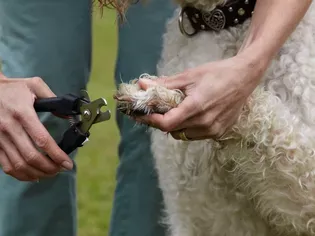How to Trim Your Dog's Nails
Updated on 04/26/24

The Ultimate Guide to Trimming Your Dog's Nails: A Comprehensive Step-by-Step Tutorial
As a loving dog owner, it's crucial to ensure your furry companion's overall health and well-being. One essential aspect of dog care often overlooked is nail trimming. While it might seem like a simple task, it requires proper technique and knowledge to avoid discomfort or injury to your beloved pet. This comprehensive guide provides you with a step-by-step tutorial, tips, and tricks to make the nail-trimming experience stress-free and effective.
Understanding Your Dog's Nails
Before you embark on the trimming process, it's essential to understand the anatomy of your dog's nails. Each nail consists of two main parts:
* Nail Body: The visible, hard portion of the nail that extends beyond the paw pad.
* Quick: A pink, vein-filled area inside the nail body that contains nerves and blood vessels.
The length and shape of your dog's nails can vary depending on their breed, activity level, and genetics. If left untrimmed, nails can grow excessively long, leading to discomfort, pain, and potential health issues.
Why Trimming Your Dog's Nails Is Important
Regularly trimming your dog's nails ensures:
* Comfort: Long nails can cause discomfort and pain when they grow into the paw pads.
* Mobility: Overgrown nails can alter your dog's gait and balance, affecting their mobility.
* Preventing Infections: Untrimmed nails can become brittle and break, creating entry points for bacteria and fungus.
* Protecting Furniture: Long nails can scratch and damage furniture and carpets.
Materials You'll Need
Before you start trimming your dog's nails, gather the following materials:
* Dog Nail Trimmer: Choose a sharp, high-quality trimmer specifically designed for dogs. There are various types of trimmers available, such as scissor-type, guillotine-type, and electric grinders.
* Styptic Powder or Cornstarch: In case of accidental cuts, these substances can help stop bleeding.
* Treats: Reward your dog for good behavior during the trimming process.
Step-by-Step Nail Trimming Tutorial
Follow these steps to trim your dog's nails safely and effectively:
1. Start Gradually: If your dog is unaccustomed to nail trims, introduce the process gradually. Start by touching their paws and holding the trimmer near their nails without cutting. Reward them with treats to make the experience positive.
2. Find the Quick: Locate the quick by examining the nail from below a bright light. It will appear as a darker, pink area. Avoid cutting into the quick, as it can cause pain and bleeding.
3. Trim Small Sections: Cut only small sections of the nail at a time. Start with a small amount and gradually trim more if needed.
4. Use the Right Angle: Hold the trimmer at a 45-degree angle to the nail and trim parallel to the ground.
5. Smooth the Edges: After trimming, use a nail file or grinder to smooth any rough edges.
6. Reward Your Dog: Throughout the trimming process, reward your dog with treats and praise. This will help them associate nail trimming with a positive experience.
Examples of Different Nail Trimmers
* Scissor-Type Trimmers: Resemble regular scissors and are suitable for small to medium-sized dogs with thinner nails.
* Guillotine-Type Trimmers: Have a circular blade that cuts the nail when you press down on the handle. Best for medium to large-sized dogs with thicker nails.
* Electric Grinders: Use a spinning wheel or file to grind down the nails. Suitable for all sizes of dogs but require careful handling to avoid over-trimming.
Tips for a Smooth Trimming Experience
* Create a Comfortable Environment: Find a quiet place where your dog feels relaxed and secure.
* Use Positive Reinforcement: Reward your dog with treats and praise throughout the process to keep them calm and cooperative.
* Take Breaks: If your dog becomes anxious or uncomfortable, pause the trimming session and try again later.
* Avoid Cutting into the Quick: If you accidentally cut into the quick, apply styptic powder or cornstarch to stop the bleeding and seek veterinary attention if necessary.
* Trim Regularly: Regular nail trimming prevents nails from becoming excessively long and makes the process easier.
Conclusion
Trimming your dog's nails is an essential aspect of their health and well-being. By following the steps and advice outlined in this comprehensive guide, you can ensure a safe and stress-free nail trimming experience for your furry companion. Remember to consult with your veterinarian if you have any concerns or if your dog exhibits any signs of nail issues. With regular care and attention, your dog's nails will remain healthy and trim, allowing them to enjoy a comfortable and active life by your side.
Explore More Pets

Basic Training
Puppy and Baby Introductions

Working Dog Breeds
All About Search and Rescue Dogs

Dog Treatments
Puppy Vaginitis: Signs, Causes and Treatment

Dog Adoption
After More Than 1,200 Days in the Shelter, Coco Goes Home

Basic Training
How to Train Your Puppy to Go on Potty Pads

Hybrid Dog Breeds
The Difference Between a Mutt, Mixed Breed, or Designer Dog?

Dog Treatments
Nail Problems in Dogs

Puppies
7 Reasons Why Two Dogs Are Better Than One